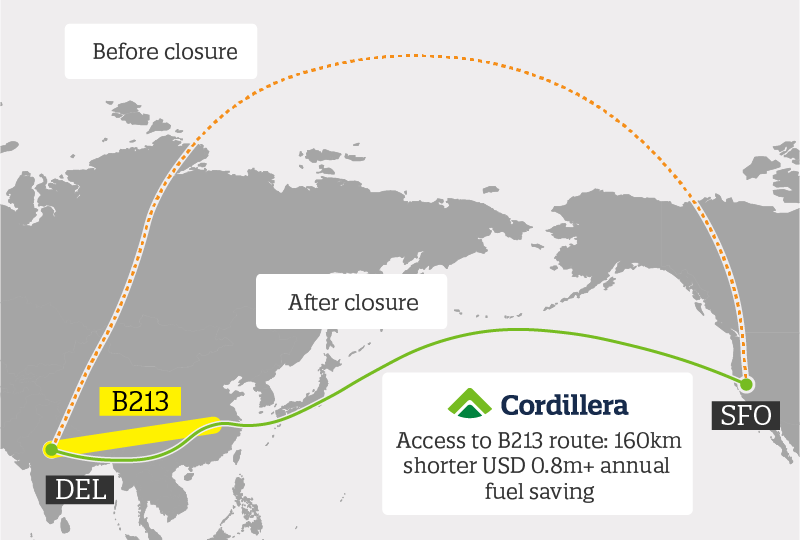Providing route flexibility to airlines in uncertain times

By Tim Wakeford, CEO, Caeli Nova
As we live through these times of geopolitical instability, airspace closures are becoming increasingly inevitable. Such closures are, of course, minor consequences in the context of tragic events such as the invasion of Ukraine and the resultant humanitarian crisis. Nonetheless, having to fly longer routes as a result of airspace restrictions is highly undesirable for airlines and their passengers, especially given increasing fuel prices. How can we safely mitigate these operational challenges?
Providing route flexibility is critical, which is where our first product, Cordillera, can help. Cordillera is an aircraft passenger emergency oxygen system which improves oxygenation in the body at high altitude during a cabin decompression emergency, meaning the aircraft can be flown at higher altitudes for a much longer duration than with traditional systems before pilots must descend to a safe breathing altitude.
Cordillera therefore opens up the most efficient flight paths over high terrain which cannot be accessed by legacy oxygen systems due to their limited duration. By opening up more direct flight paths over high terrain, the system minimises the length of routes without compromising passenger safety, which, by reducing fuel consumption and carbon emissions, enables airlines to mitigate the cost and environmental impacts of airspace closures.
For example, a carrier seeking to fly from Delhi to San Francisco whilst avoiding the route through the now-closed Russian airspace, could seek to fly south of Russia instead. Using Cordillera would allow the airline to access the direct B213 airway from India toward the Pacific Ocean, helping to minimise the length of the alternative route taken.

Similarly, regime change in Afghanistan has led aviation authorities including the European Union Aviation Safety Agency (EASA) to restrict flying over that country, seeking to ensure the safety of air travel between Europe and Asia. The P500 airway over the narrowest stretch of the Wakhan corridor – a strip of Afghan land that reaches into Tajikistan, Pakistan and China – does remain open, but is inaccessible to many aircraft because of the limitations of their oxygen systems. Such aircraft – if flying from Paris to Bangkok avoiding Afghanistan, for example – would therefore not be able to use the P500 airway and would have to take a longer route south of Afghanistan. By not being able to access P500, the aircraft uses an extra tonne of fuel and releases over three tonnes of extra CO2 emissions. Aircraft with Cordillera, however, would be able to access the attractive shorter route using the P500 airway saving over $1,000 per flight for the operator.
These routing issues intensify when soaring fuel prices become part of the problem too. We’ve previously calculated Caeli Nova’s annual benefit to the global aviation industry as a $480million saving, based on 2019 fuel prices. But with fuel prices currently much higher, we can recalculate that benefit number to deliver a $600million saving.
Rising fuel prices and airspace closures are a difficult combination for airlines. Any measures which safely deliver the most direct flights should be taken.
- 01/17/22 01 2022 Airspace closures over Afghanistan: How can airlines manage the effects?
- 07/20/21 07 2021 What are the world’s most challenging routes and airport approaches?
- 10/03/22 10 2022 MRO Business Today | Press Coverage
- 06/14/22 06 2022 Caeli Nova wins Cabin Systems category at the Crystal Cabin Awards
- 06/14/22 06 2022 Aviation Week | Press Coverage